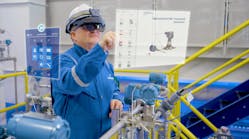Manufacturing Day 2019: 3 ways technology is a “must-have” to ensure safety for the modern industrial worker
October 4 was Manufacturing Day, a day designed to inspire the current and next generation of manufacturers. There’s no doubt that attracting and retaining early career talent is paramount to the success of U.S. manufacturing, especially amid the growing concern about the number of manufacturing jobs that will go unfilled in the future.
There are many ways in which the industry can make manufacturing a more attractive career path to young people. One of the keys is to reflect on how people have been taught in schools and in universities over the last decade. The six-inch binder is not the tool of choice for younger people to learn and do their jobs – it’s digital. Technology needs to be at the forefront of this conversation; giving industrial workers modern digital tools to streamline processes and ensure their work is being performed with precision and care helps new recruits view manufacturing as a modern, rewarding industry.
However, while offering more efficient workflows absolutely tackles some of the misperceptions around a career in manufacturing, there is an additional aspect to technology that will make this field more enticing: creating safer work environments.
The U.S. Bureau of Labor Statistics reported late last year that there were a total of 5,147 fatal work injuries in 2017 – many of which were comprised of workers in industrial environments. That total number is almost unchanged from a decade ago, so it’s clear the world must do better in making work safer. There is a high correlation between safety and productivity, especially if safety practices can avoid episodic and often catastrophic incidents.
One of the best ways to ensure safety is to reduce the potential for human error. Human error accounts for many work safety incidents, and in the manufacturing world, those incidents can be incredibly dangerous. From incorrect operation of machinery to failure to follow protocol, human error on the plant floor is a major risk to everyone. Humans are smart, attentive and motivated, but in industrial environments – especially under stress – more help is needed.
That’s where technology comes in to guide and drive adherence to safety best practices. With these modern digital tools, safety becomes embedded into the daily work execution, not a separated set of tasks managed by the environmental, health and safety team.
Ensure consistently safe work across the board
Consistency is a fundamental pillar of the 5S methodology, which is essentially a system for organizing the workplace. Part of the concept is to instill order throughout operations, eventually leading to better standardized practices and sustained, effective management. Advancements in technology can help organizations bring this concept to life.
Modern connected worker software helps combat risks by integrating safety checks within the work execution itself. It can cue up specific reminders and procedures by assessing the safety characteristics of each task or job. This is done through digitized, in-line procedural information, which helps to ensure workers don’t miss critical steps in a process – be it reminding workers to wear a hard hat or mask when working in certain parts of the plant, or a final equipment checklist. Multimedia content, like videos, within digital procedural instructions can provide additional assurance that a process is being followed correctly by giving workers a step-by-step visual of how to complete each of their actions effectively and safely.
These cues, reminders and checklists ultimately lead to the 5S concept: more order and consistency in the work being done. Following a standardized process guided by modern technology to operate machinery and safely turn on or shut down dangerous equipment, for example, leads to stronger adherence to safety processes by everyone.
Unlock hidden data that can improve safety
Apart from the tactical ways technology improves safety, it also provides insight and more visibility into specific processes. Data is king when it comes to this kind of transparency and helps leaders make better decisions, especially ones that relate to safety.
Modern connected worker software, through a historical digital data record, provides real-time access to processes as they occur and gathers detailed data like length of tasks, efficiency comparisons of different processes, bottlenecks in production and/or ratio of severe injury incidents versus general incidents. Deeper analysis into calculations like recordable incident rate (RIR) or lost time injury frequency rate (LTIFR) are another benefit. Data can even be drilled down to the plant, process and shift level.
This level of reporting allows workers and managers alike to identify potentially risky issues and uncover trends that lead up to dangerous environments. Being able to analyze operations with more of a bird’s-eye view offers the ability to side-step potentially dangerous scenarios in plant operations.
Enable collaborative response to safety incidents
Finally, it’s important to never underestimate the power of collaboration as it applies to safety. Mobile-first connected worker software can help curb hazardous situations by enabling real-time communications between frontline workers and the back office, as well as across different sites. It also enables people to share videos or photos of the work they’re doing as they’re doing it, and instantly message colleagues if they have questions or need a gut-check of their work. A more interactive work environment and having a constant feedback loop are essential to promoting safety.
For example, technology can enable remote workers out in the field to notify their team of "near miss" problems as they occur. The speed at which workers can share information makes it possible for the appropriate people or parties to get involved with equipment or procedure issues right away and track, triage and resolve an incident before it causes harm.
Workers also have the capability to track each other’s work and provide a better understanding of procedures while they’re in progress. This is important especially during shift handovers. Technology allows people to digitally capture where they left off in their work so the incoming shift has a clear idea of what has or hasn’t been accomplished. This makes for better quality work and reduces the risk of mistakes, like skipping key procedural steps accidentally.
There are so many ways modern technology is making industrial environments safer and more reliable. Companies that prioritize and invest in this will not only win the battle for future talent, but preserve their existing workforce as well.
Lawrence Whittle is the CEO of Parsable, provider of the leading connected worker platform built to digitize, execute, measure and transform industrial work at scale. Companies with operations in more than 130 countries rely on Parsable to empower their workers with modern, digital tools and improve productivity, quality and safety across their operations.



